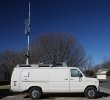|
Each antenna port is basically a transmit receive chain. They have always been intended to work in tandem to cover the same area. The individual ports have been used (abused) by some in the past to create links that do not cover the same general coverage area as it was the only way at the time to link distant networks. This is a habit I'm looking to see to be broken. The much better and really only reasonable method (based on hardware design) is to use DTDLINK to link nodes together. Both antenna ports (on those devices that have them) can then be used to cover the same area letting you do dual polarity which can increase the performance of the network. Also it may be wise for any real deployment to look towards the Ubiquiti gear over Linksys (use Linksys only for in lab experimentation and learning while the real nodes get that better RF performance of Ubiquiti) |
